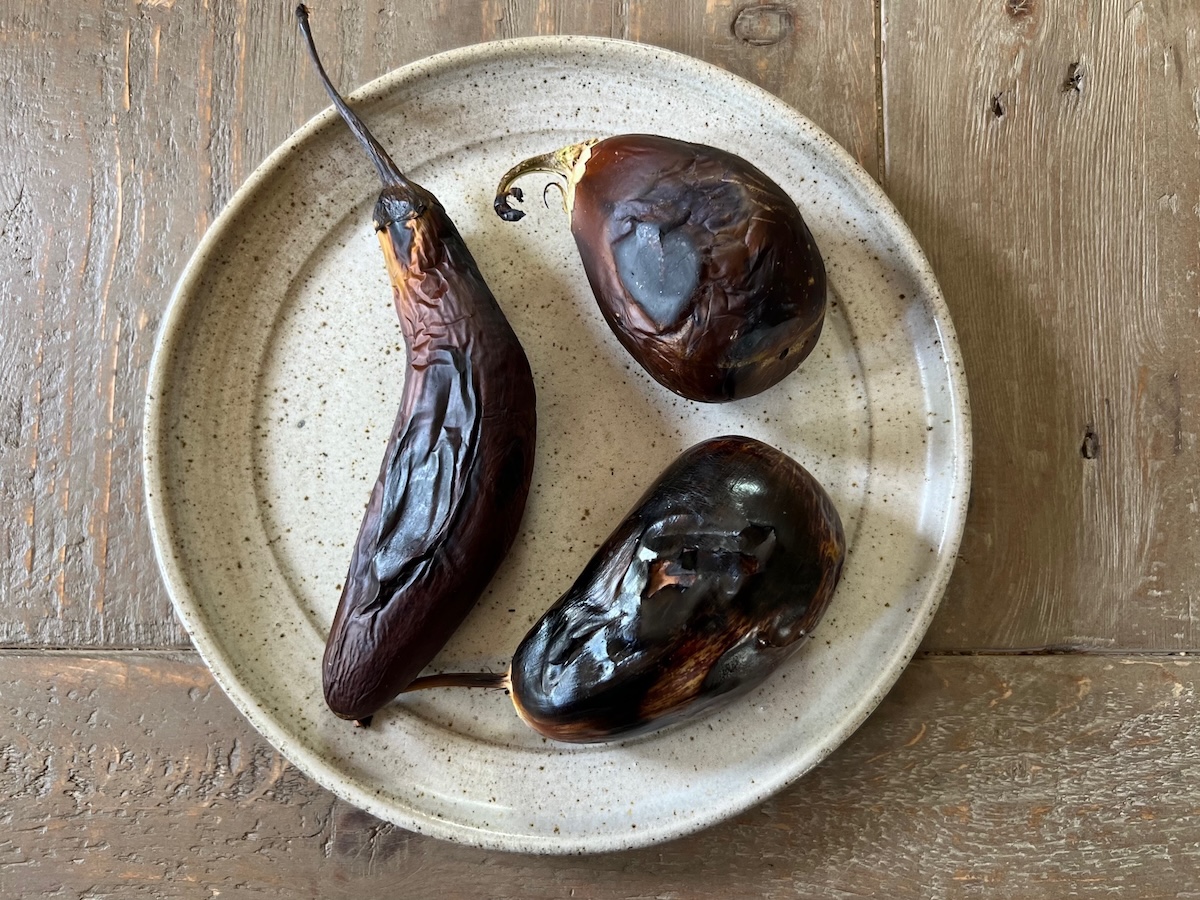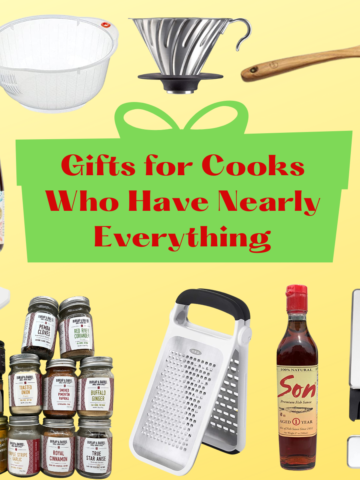Charring vegetables can magically coax out their natural sweetness, render them plush, and/or impart an outdoorsy smokiness. The transformation depends on the vegetable chosen, the tool and method used, plus the cook's overall purpose.
For something like pho, aromatics such as shallots, onions, or ginger were traditionally set on a metal grill atop a charcoal brazier. The aim was to mostly blacken their skins and partly render their fleshy insides somewhat sweeter, less harsh, so they'd add complexity to an old-fashioned pot of beef pho or chicken pho. Ditto for charring and smoking eggplant for favorites such as Indian baigan bharta, Arabic baba ghanoush, and Vietnamese ca tim nuong mo hanh (grilled eggplant with scallion oil)
But who wants to get charcoal going? It's too much trouble for most modern cooks. You have choices. This post reviews some tools and method for efficiently charring vegetables for your recipes.

Basic, direct flame contact
If you have a gas stove, gas grill, side burner on a gas grill, or portable butane/propane burner -- set the vegetable on the grate over a medium to medium-high flame. Aim for the flames to be close to the vegetable. (An old fashioned electric coil burner apparently works too but you need to take great care when using it. You're putting it directly on the coils!) Turn it regularly to blister and char. Make sure the exhaust fan is on. When done, rest the vegetable in a bowl, covered, to steam for 10 minutes to loosen the skin. Then peel.

- Pros: No special tool required. Strong smoky flavor.
- Cons: Grates don't permit charring a lot at once or smallish vegetables. Cooking can get out of hand and drips from the vegetables will require stovetop clean up.
- Buy: Grill Boss propane/butane burner (12K BTU)
How about a broiler? Garlic, onions, ginger and shallots do okay charring close to a broiler element. Peppers and eggplant tend to cook to a super softness and release a lot of liquid under the broiler without getting enough smokiness. If you're ok with that, turn up the broiler.
Cast iron or carbon steel skillet
No direct heat options available? For electric or induction stoves, some cooks default to heating a cast iron or carbon steel frying pan until super duper hot and then putting the vegetable on it. There will be some charring but it's very subtle and mild.

- Pros: Makes good use of a cast iron or carbon steel skillet.
- Cons: Does not yield a super smoky flavor. The charring takes a longer than with direct heat/direct flame contact.
- Buy: Carbon steel skillets are my jam because they heat fast, are relatively lightweight, and just as hard working as cast iron. Brands I've test driven and like include Made In (what I used above), Mauviel and de Buyer
Flimsy but fine roti grill
Want to steady veggies when charring over direct heat? Try a South Asian roti grill. It's meant for heating flatbread or papads over an open flame but it can do more!

- Pros: The compact grills are inexpensive (about $10 on Amazon or less at a South Asian grocer) and the handle is handy! You can grill more than one veggie at a time.
- Cons: Relatively flimsy. The metal is cheap and is not meant to get super hot. No blasting the heat.
- Buy: Tabakh on Amazon, or check with an Indian grocer
Fast blasting vegetable grilling pan/basket
Perforated pans meant for grilling vegetable and other easy-to-fall-through-the-grates foods are fantastic for charring vegetables on a gas or induction stove (sorry I don't have a regular electric stove).
The pans look like skillets and are sometimes marketed as "grilling baskets". Basically, they're high-heat pie pans with holes on the bottom. Use them on medium-high or medium heat because they get super hot, super fast. They remind me of pans used to roast chestnuts.


- Pros: Hold lots lots of veggies for charring. Good, fast exposure to heat source, even on induction. Durable when made of carbon steel or cast iron (I avoid thin stainless steel which may warp). You can rest oddly shaped veggies on the rim or on the center bump to strategically char. Store with other skillets.
- Cons: Washing can be a chore because of all the holes. The heat can be fierce so there can be leakage onto your stovetop. Clean up is minimal though.
- Buy: OXO Obsidian (pre-seasoned carbon steel, this is what I used above), Made In (thicker carbon steel than OXO), Lodge (cast iron so heavier than carbon steel; I would avoid Lodge's carbon steel pan with many slits to wash)
Kozmatik Turkish wonder
Resembling a pie plate with gills, the Turkish grilling pan that's popularly sold under the name Kozmatik allows you to grill at moderate speed. It may feel flimsy because the metal is thin but word from heavy users is it will last for years. There's just enough flame contact to impart a delicate smoke.

- Pros: Provides solid, even flame and heat exposure for balanced smoke and char.
- Cons: Thin metal. The shape and size is unusual so it doesn't easily nest with other items in the kitchen. Hard to source in many places.
- Buy: 177 Milk Street, Ebay
Which is the best tool?
I was surprised at how smoky and evenly the vegetables charred on the perforated pan, both on the gas stove and induction burner. If you want to buy a tool, I strongly consider that one. It's designed to work outdoors so you can take the pan outside!
What do cook with all your charred veggies?


How about:
- Baingan bharta (vegan)
- Fried eggplant banh mi (vegetarian)
- Dashi-soaked eggplant
- Smoky eggplant with chili scallion oil (vegetarian and vegan adaptable)
- Beef pho
- Chicken pho
How do you char veggies to smoky perfection? Do share!

















Thalia says
I never thought about using my perforated grilling pan inside on my gas stove! Brilliant, brilliant, brilliant! (Channeling the character Izma, by Eartha Kitt) I am so excited to try it. Too bad my eggplant plant pooped out, but I've got plenty of other veggies in the house! Thanks for testing, Andrea. I love how you share your experiments!
Andrea Nguyen says
I didn't either until very recently. They're made for outdoor cooking -- sometimes marketed for stir-frying on the grill (that sounds so awful to clean up!). I bought a stainless steel perforated sheet pan thing for skewers and the like but it was a waste of money. This holey skillet/pie pan thing turned out to be really great to mimic grates. Eartha Kit!!!!!
Ellen Rigsby says
I have been wondering about the perforated pans on my induction stove! Thanks for testing these.